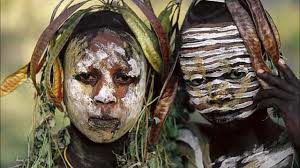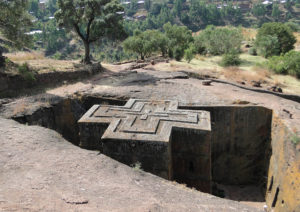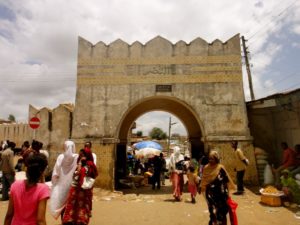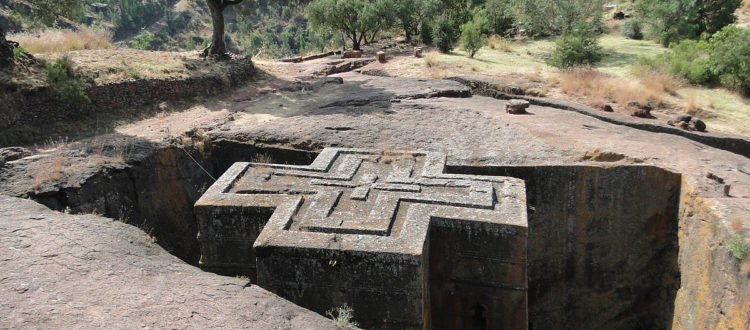Ethiopia’s UNESCO World Heritage Sites
The Castle of Gondar
Gondar, the 17th century capital of Ethiopia, is located about 748 km North Western of Addis Ababa. The city is well  known for its Castles and churches .Its medieval glory is reflected in the famous castles of the emperors of the time, especially that of Emperor Fasiledas.The Castles of Gondar are today the most visible expression of the relatively near past history of Ethiopia.
known for its Castles and churches .Its medieval glory is reflected in the famous castles of the emperors of the time, especially that of Emperor Fasiledas.The Castles of Gondar are today the most visible expression of the relatively near past history of Ethiopia.
The castles of king Fasil’s legacy dated back to the 17th century AD. There exists no instance of this kind in Africa, often described as the Camelot of Africa, Fasil compound/ Fasil Gheebi / served as the royal residence of Ethiopian Emperor Fasiladas and his successors at a time, when Gondar was the country’s capital. Enclosed within the 900-meter long wall are crenellated castles, palaces, churches and other buildings, some of them still intact enough to give an excellent impression of the Era. Just outside the fortress city, there is another fine building sometimes associated by Fasiledas, a bathing place which is filled with water these days once a year to commemorate the Ethiopian Epiphany / Timiket / festival. Around the famous royal compound, visitors are encouraged to visit the ruins of the 18th century palace of Empress Mintiwab and the spectacular church of Debre Birhan Selassie which is still incredibly graceful in its magnificent paintings.
Lower Omo Valley
The Lower Valley of Omo is located in South-Western Ethiopia. The age old sedimentary deposits in the Lower Omo Valley are now world renowned for the discovery of many hominid fossils, that have been of fundamental importance in the study of human evolution.
Ancient tools and hominid fossils dating back 2.4 million years ago have been discovered there. The area is also home to a huge cultural diversity of people. The Lower Valley of Omo is one of the unique places in the world in that so many various cultures inhabit such a relatively small piece of land.
The Rock-Hewn Churches of Lalibela
The churches which are carved out of solid rock have fascinating internal channels and walls full of religious

symbols.These amazing edifices were not constructed as such, but were chipped out of solid rock with only hammers and chisels. The churches of Lalibela indicate the architectural mastery and religious devotion of king Lalibela who is believed to have built them. It is the site of eleven remarkable rock hewn churches believed to have been built in the late 12th or early 13th century. The town was originally called Roha, but was renamed after king Lalibela who commissioned the churches.
The Walled City of Harrar
The city of Harrar, one of the oldest cities in the country, was founded in the 7th c

entury A.D Harrar was a major trading crossroad and a center of Islamic learning. Fortified against invaders, its provocative five gate wall (Jugol) was built between the 13th and 16th centuries.
The town is famous for unique layout of its houses, its intricate basketry, coffee and hyena feeding.The narrow winding streets of Harrar contain over 99 mosques and are considered as the fourth holiest city of Islam, next to Mecca, medina and Jerusalem.
The Stelae of Axum
Truly; Aksum was ahead of its time. Unlike many other state of the time, Aksumites knew how to tame animals,

cultivate cereals, mint coins and curve extraordinary obelisks which are unknown to human kind.They accepted Christianity early, developed their unique Alphabet and created a peculiar system of composing and chanting religious hymns. Indeed, Aksum was the most inventive state of its time, shaped and reshaped by profound faith, sophisticated administration, boundless prosperity and artistic and engineering brilliance. In terms of its sanctity as well as greatness of its empire, Aksum is like Jerusalem and Rome combined .In essence, Aksum is faith, holiness, history and tranquility all wrapped in one.
Presently, Aksum houses seven giant stealea, some of them are fallen. One of the obelisks was taken to Rome where it was installed for many years. And it has been returned to Ethiopia and re-erected on its original place in Axum. The ruins of the Queen of Sheba’s palace, as well as the Ark of the Covenant are found in Axum. These days Axum is considered as one the holiest destinations of many Christian pilgrimages.
The Semien Mountains National Park
Established in 1969 and made a UNESCO World Heritage Site nine years later , the 220km sq Semein Mountains National Park protects the western part of the eponymous mountain range , a serious of incised plateau characterized by sheer 1,000m-high cliffs and rugged pinnacles and buttresses.
The range includes at least a dozen peaks that top the 4,000m mark, among them the 4,620m Ras Dashen ,which is the fourth–highest mountain in Africa.Situated about 100km north of Gonder and best assessed from the small town of Debark, the park is best known for stupendous scenery lauded Rosita Forbes as ‘the most marvelous of all Abyssinian landscapes’, but it is also the most important stronghold for the endemic Gelada Baboon,Walia Ibex and Abyssinian Wolf, as well as hosting one the world’s densest populations of the spectacular bearded vulture(wammergeyer), which is frequently seen at close range at the campsites.
Tiya Stones
Tiya is among the most important of the roughly 160 archaeological sites discovered so far in the Soddo area, south of Addis Ababa.
The pre historic site of Tiya in Southern Ethiopia houses 36 obelisks, including 32 carved stelae covered with  symbols, believed to be ancient tomb stones. According to UNESCO, these are the remains of ancient Ethiopian cultures whose age has not yet been precisely determined. The erection of megalithic monuments such as those is a very ancient tradition in Ethiopia. These obelisks are not soaring monoliths as in Axum, but they contain depictions of swards and various symbols not found in other regions.
symbols, believed to be ancient tomb stones. According to UNESCO, these are the remains of ancient Ethiopian cultures whose age has not yet been precisely determined. The erection of megalithic monuments such as those is a very ancient tradition in Ethiopia. These obelisks are not soaring monoliths as in Axum, but they contain depictions of swards and various symbols not found in other regions.
The carved monoliths vary in size from 1 m to 5 m. Their forms fall into several distinct categories: figurative composition, anthropomorphic, hemispherical or conical, simple monoliths. In the northern area are to be found stelae with depictions of swords, associated with enigmatic symbols and schematic human figures.
Lower Awash
Just over the bridge, turn right to follow a dirt road to the archaeological site of Melka Konture. (It is best that you check with the Antiquities Administration in Addis first.) Since 1965, geologists and archaeologists have had a compound here, set up to excavate this area at the entrance to the gorge where, two million years ago, the earliest ancestors of mankind had a home.
They left behind tools, as well as traces of meals and shelters. In the lowest levels pebble tools have been found and, in the higher levels, men of the Middle and Late Stone Age have left many examples of beautiful two-edged hand-axes, obsidian scrapers, and sets of ‘bolas’ – the round stones used together in nets to throw at animals. Fossilized bones of hippopotamus, rhinoceros, elephant, and various antelope have also been found here.
If you walk upstream along the banks of the river, some of these Stone Age tools can often be seen, particularly in the dry washes. Remember, however, that collecting of Stone Age artefacts is prohibited, and local citizens help to enforce this restriction.
Lucy, 3.5 million years old, and the recent discovery Ramides, 4.4 million years old hominid fossil, are discovered in Haddar, along the Awash River, east of the country. They completed the missing link between Apes and men.
Melka Konture is also an important archeological site where 1.5 million years old stone tools were found. Several cave paintings and stone monuments are found in different parts of the country like Dilla, southern Ethiopia and Dire Dawa, eastern Ethiopia.
Konso Cultural Landscape
Konso Cultural Landscape is a 55 square km arid property of stone walled terraces and fortified settlements in the Konso highlands of Ethiopia. It constitutes a spectacular example of a living cultural tradition stretching back 21 generations (more than 400 years) adapted to its dry hostile environment.
The landscape demonstrates the shared values, social cohesion and engineering knowledge of its communities.The site also features anthropomorphic wooden statues – grouped to represent respected members of their communities and particularly heroic events – which are an exceptional living testimony to funerary traditions that are on the verge of disappearing. Stone steles in the towns express a complex system of marking the passing of generations of leaders.
The cultural properties including the traditional stone wall towns (Paletea), ward system (kanta), Mora (cultural space), the generation pole (Olayta), the dry stone terracing practices (Kabata), the burial marker (Waka) and other living cultural practices are reasons for the precipitation of the Konso cultural landscape to be listed on UNESCO world heritage sites list. All the necessary requirements have completed including, field studies, data collections, nomination file/document and management plan of the Konso Cultural Landscape.
Terrace: The Konso have adapted a terrace agricultural system and the core Konso area is characterized by extensive dry stone terraces.Theses terrace retain the soil from erosion and
create terrace saddles that are used for agriculture. The terraces are the main features of the Konso landscape and the hills are contoured by the dry stone terraces that could reach at some places up to 5m high. The terraces retention walls are built with heavier blocks at the base. The saddles that are prepared for agriculture are between four and eight meters wide at most places
The walled town (Paleta): The Konso live in dry stone walled towns (Paleta) located on high hills selected for their strategic and defensive advantage. The Knoso villages remarkable for the beauty and simplicity of its workmanship, constructed entirely from natural materials, cultivated or constructed from the surroundings. The village is ringed by dry stonewalls, at least a meter thick and three meters high.
Mora: Cultural space of Konso located at the center of the main central enclosure and at different locations with in the walls, and sometimes outside the walls. Paths from all gates lead to these Moras. The individual walled town (Paleta) has up to 17 Moras, which are connected to one other by footpaths. The Moras retain an important and central role in the life of the Konso. They usually have one or two-story grass thatched houses, called Pafta. The Mora comprise an open sided sitting area beneath a huge thatched roof with a heavy wooden ceiling and above the ceiling there is therefore an ;ittic’ the ground floor of the Mora is expertly paved to form a public area where the men gather to govern the village life. It is also a place for recreation, the youth may gather here to play chat and relax during the day when they are not working. The attic of the Mora meanwhile is where all the adult men are obliged to slip at night. They have a responsibility to protect the villages from various an expected incidences such as fire and any other attack.




